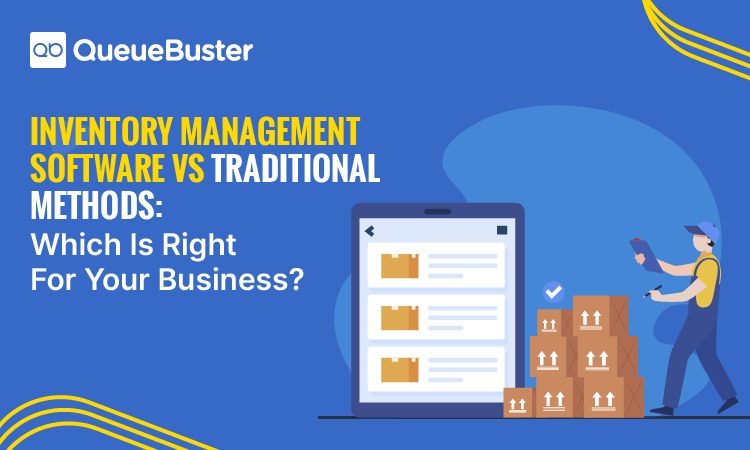
Inventory Management Software Vs. Traditional Methods: Which Is Right For Your Business?
Inventory Management Software Vs. Traditional Methods: Which Is Right For Your Business?

By QueueBuster Team Published: February 13th, 2024
Inventory management is crucial for any business that deals with physical products. It involves tracking and controlling the flow of goods from the supplier to the warehouse, and ultimately to the customer. While traditional methods of inventory management, such as manual record-keeping and spreadsheets, have been used for years, advancements in technology have led to the development of inventory management software that can make the process more efficient.
However, with so many options available in the market, choosing the right inventory management method can be a daunting task for small businesses. Some may wonder if inventory management software is necessary or if they should stick to traditional methods.
In this article, we will explore the pros and cons of both inventory management software and traditional methods, and help you decide which one is the right fit for your business. So, whether you’re a grocery store, a hardware store, or a departmental store, read on to find out which option suits your business needs best.
Inventory Management with POS
If you’re using a point-of-sale (POS) system to manage your sales, it makes sense to use the same system to manage your inventory as well. POS systems for inventory management can provide a more integrated and automated approach to managing your stock. With a POS system, you can track inventory levels in real-time, automate purchase orders, and even set up reorder alerts.
Using a POS system for inventory management can also help you identify your best-selling products, monitor the movement of slow-moving products, and avoid stockouts. By integrating your sales data with your inventory data, you can gain a better understanding of your business’s needs and make informed decisions about your stock levels.
Error: Contact form not found.
However, not all POS systems come with inventory management features, and not all inventory management (IM) software solutions integrate with your POS system. Therefore, it’s essential to research and chooses a POS system or IM software that suits your business needs.
POS Systems for Inventory Management
As mentioned earlier, using a POS system for inventory management can provide several benefits. But not all POS systems are created equal when it comes to inventory management. Some systems have more robust features than others, so it’s essential to consider your business’s specific needs.
Here are some features to look for when choosing a POS system for inventory management:
- Real-time inventory tracking: The system should provide real-time updates on inventory levels to avoid stockouts and overstocking.
- Automated purchase orders: The system should generate purchase orders automatically when inventory levels fall below a certain threshold.
- Barcode scanning: The system should have the ability to scan barcodes to quickly update inventory levels.
- Stock movement tracking: The system should allow you to track the movement of stock between different locations and employees.
- Reporting and analytics: The system should provide detailed reports and analytics on inventory levels, sales, and stock movement.
- Integration with IM software: If you have a separate inventory management software, ensure that it can integrate with your POS system to avoid duplicate data entry.
By considering these features, you can choose a POS system that meets your inventory management needs and helps you streamline your operations.
Free Inventory Management Software
If you’re running a small business and have a limited budget, you might be hesitant to invest in expensive software for inventory management. Fortunately, there are several free inventory management software options available in the market. These software tools offer basic features like tracking inventory levels, generating reports, and setting reorder points.
While free software can be a good option for small businesses with limited inventory and simple requirements, they may not offer the advanced features of paid options. You may also need to consider the limitations on the number of products or users you can manage with free software.
Some popular free IM software options are ABC Inventory, inFlow Inventory, and Odoo Inventory. These software tools can be a good starting point for businesses that want to try out IM software without making a significant investment.
However, it’s essential to keep in mind that free inventory management software may have limited customer support, and the software’s security may not be as robust as paid options. Therefore, if you have complex inventory management needs, it may be worth investing in a paid solution that provides more extensive features, integrations, and customer support.
Traditional Methods of Inventory Management
Traditional methods of inventory management refer to manual systems that involve physically counting and tracking inventory levels. These methods typically involve the use of pen and paper, spreadsheets, or other basic tools to manage inventory. While traditional methods may be suitable for small businesses with low inventory volumes, they can be time-consuming and prone to human error.
One of the main disadvantages of traditional inventory management methods is the lack of real-time inventory tracking. With manual systems, inventory levels are typically updated periodically, which can lead to inaccuracies and stockouts. Additionally, traditional methods do not provide the detailed insights and analytics that modern inventory management software can offer.
Another significant challenge of traditional inventory management methods is the difficulty of scaling operations. As businesses grow and inventory volumes increase, it becomes increasingly difficult to manage inventory levels effectively using manual systems. This can result in inefficiencies, stockouts, and lost sales opportunities.
Overall, while traditional inventory management methods may be suitable for small businesses with low inventory volumes, they can be cumbersome and challenging to manage effectively. As businesses grow and inventory volumes increase, it becomes increasingly important to adopt modern inventory management tools and techniques to ensure efficiency, accuracy, and scalability.
Error: Contact form not found.
In conclusion, inventory management is crucial for the success of any business, big or small. With technological advancements, inventory management software has become a popular option for businesses looking to streamline their operations. However, traditional methods of inventory management still have their benefits, especially for smaller businesses with lower inventory volumes.
5 Ways to Clear Your Retail Stock Before It Expires
When it comes to choosing the right inventory management solution for your business, it is important to consider your business needs, budget, and goals. POS systems for inventory management can provide a wide range of benefits, including real-time inventory tracking, accurate sales reporting, and improved customer satisfaction. On the other hand, free inventory management software can be a cost-effective option for small businesses that need basic inventory management features.
Regardless of the solution you choose, having a well-managed inventory system is key to the growth and success of your business. At QueueBuster, we understand the challenges that small businesses face and offer a POS app that can help manage inventory, customer relationships, loyalty, billing and invoicing, and online catalogs effectively. Book a demo today to learn more about how QueueBuster can help take your business to the next level.
Popular Posts

Carbon Credit Companies in India: Driving Climate Action Through Innovation
As India accelerates toward sustainable development and net-zero targets, carbon credits are […]

Return Inwards & Outwards: Meaning & Examples
In a fast-paced world, inventory-driven market like India, managing your stock and […]